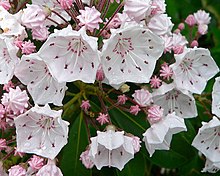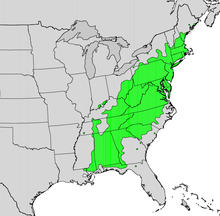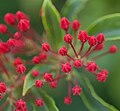Kalmia latifolia
| Kalmia latifolia | |
|---|---|

| |
| Scientific classification | |
| Kingdom: | Plantae |
| Clade: | Tracheophytes |
| Clade: | Angiosperms |
| Clade: | Eudicots |
| Clade: | Asterids |
| Order: | Ericales |
| Family: | Ericaceae |
| Genus: | Kalmia |
| Species: | K. latifolia
|
| Binomial name | |
| Kalmia latifolia | |

| |
Kalmia latifolia,themountain laurel,[3]calico-bush,[3]orspoonwood,[3]is aspeciesofflowering plantin the heath familyEricaceae,that is native to theeastern United States.Its range stretches from southernMainesouth to northernFlorida,and west toIndianaandLouisiana.Mountain laurel is thestate flowerofConnecticutandPennsylvania.It is the namesake ofLaurel Countyin Kentucky, the city ofLaurel, Mississippi,and theLaurel Highlandsin southwestern Pennsylvania.[4]
Description[edit]
Kalmia latifoliais anevergreenshrub growing 3–9 m (9.8–29.5 ft) tall. The leaves are 3–12 cm long and 1–4 cm wide. The flowers are hexagonal, sometimes appearing to be pentagonal, ranging from light pink to white, and occur in clusters. There are several namedcultivarsthat have darker shades of pink, red and maroon. It blooms in May and June. All parts of the plant are poisonous. The roots are fibrous and matted.[5]
Distribution and habitat[edit]
The plant is naturally found on rocky slopes and mountainous forest areas. It thrives inacid soil,preferring asoil pHin the 4.5 to 5.5 range. The plant often grows in large thickets, covering great areas offorest floor.In theAppalachians,it can become a tree but is a shrub farther north.[5]The species is a frequent component ofoak-heath forests.[6][7]In low, wet areas it grows densely, but in dry uplands has a more sparse form. In the southern Appalachians, laurel thickets are referred to as "laurel hells" because it is nearly impossible to pass through one.
Ecology[edit]
Kalmia latifoliahas been marked as a pollinator plant, supporting and attractingbutterfliesandhummingbirds.[8]
It is also notable for its unusual method of dispensing its pollen. As the flower grows, the filaments of itsstamensare bent and brought into tension. When an insect lands on the flower, the tension is released, catapulting the pollen forcefully onto the insect.[9]Experiments have shown the flower capable of flinging its pollen up to 15 cm.[10]PhysicistLyman J. Briggsbecame fascinated with this phenomenon in the 1950s after his retirement from theNational Bureau of Standardsand conducted a series of experiments in order to explain it.[11]
Etymology[edit]
Kalmia latifoliais also known asivybushorspoonwood(because Native Americans used to make their spoons out of it).[12][13]
The plant was first recorded in America in 1624, but it was named after the Finnish explorer and botanistPehr Kalm(1716–1779), who sent samples toLinnaeus.
The Latinspecific epithetlatifoliameans "with broad leaves" – as opposed to its sister speciesKalmia angustifolia,"with narrow leaves".[14]
Despite the name "mountain laurel",Kalmia latifoliais not closely related to the true laurels of the familyLauraceae.
Cultivation[edit]

The plant was originally brought to Europe as anornamental plantduring the 18th century. It is still widely grown for its attractive flowers and year-round evergreen leaves. Elliptic, alternate, leathery, glossy evergreen leaves (to 5 "long) are dark green above and yellow green beneath and reminiscent of the leaves of rhododendrons. All parts of this plant are toxic if ingested. Numerouscultivarshave been selected with varying flower color. Many of the cultivars have originated from the Connecticut Experiment Station inHamdenand from the plant breeding of Dr. Richard Jaynes. Jaynes has numerous named varieties that he has created and is considered the world's authority onKalmia latifolia.[15][16]
In theUKthe following cultivars have gained theRoyal Horticultural Society'sAward of Garden Merit:
- 'Freckles'[17]– pale pink flowers, heavily spotted
- 'Little Linda'[18]– dwarf cultivar to 1 m (3.3 ft)
- 'Olympic Fire'[19]– red buds opening pale pink
- 'Pink Charm'[20]
Wood[edit]

The wood of the mountain laurel is heavy and strong but brittle, with a close, straight grain.[21]It has never been a viable commercial crop as it does not grow large enough,[22]yet it is suitable for wreaths, furniture, bowls and other household items.[21]It was used in the early 19th century in wooden-works clocks.[23]Rootburlswere used for pipe bowls in place of importedbriar burlsunattainable duringWorld War II.[22]It can be used for handrails or guard rails.
Toxicity[edit]
Mountain laurel ispoisonousto several animals, includinghorses,[24]goats,cattle,deer,[25]monkeys, and humans,[26]due tograyanotoxin[27]andarbutin.[28]The green parts of the plant,flowers,twigs, andpollenare all toxic,[26]including food products made from them, such astoxic honeythat may produce neurotoxic andgastrointestinalsymptoms in humans eating more than a modest amount.[27]Symptoms oftoxicitybegin to appear about 6 hours following ingestion.[26]Symptoms include irregular or difficulty breathing,anorexia,repeated swallowing, profusesalivation,watering of the eyesand nose, cardiac distress, incoordination, depression,vomiting,frequentdefecation,weakness, convulsions,[28]paralysis,[28]coma,and eventually death.Necropsyof animals who have died from spoonwood poisoning show gastrointestinalhemorrhage.[26]
Use by Native Americans[edit]
TheCherokeeuse the plant as ananalgesic,placing aninfusionof leaves on scratches made over location of the pain.[29]They also rub the bristly edges of ten to twelve leaves over the skin forrheumatism,crush the leaves to rub brier scratches, use an infusion as a wash "to get rid of pests", use a compound as aliniment,rub leaf ooze into the scratched skin of ball players to prevent cramps, and use a leaf salve for healing. They also use the wood for carving.[30]
Gallery[edit]
-
K. latifolialeaves and early buds
-
Flower buds
-
Beginning to bloom
-
Full bloom
-
Blooming and wilted flowers on the same flower head
-
Bee pollinating mountain laurel on Occoneechee Mountain
-
Kalmia latifoliainNorth Smithfield, Rhode Island
References[edit]
- ^Stritch, L. (2018)."Kalmia latifolia".IUCN Red List of Threatened Species.2018:e.T62002834A62002836.doi:10.2305/IUCN.UK.2018-1.RLTS.T62002834A62002836.en.Retrieved19 November2021.
- ^"NatureServe Explorer 2.0 - Kalmia latifolia".explorer.natureserve.org.Retrieved4 May2020.
- ^abc"Kalmia latifolia".Germplasm Resources Information Network.Agricultural Research Service,United States Department of Agriculture.Retrieved12 December2017.
- ^Stich, Kelly (2021-06-11)."How the mountain laurel became Pennsylvania's state flower".Pennsylvania Wilds.Retrieved2024-01-31.
- ^abKeeler, Harriet L. (1900).Our Native Trees and How to Identify Them.New York: Charles Scribner's Sons. pp.186–189.
- ^The Natural Communities of Virginia Classification of Ecological Community Groups(Version 2.3), Virginia Department of Conservation and Recreation, 2010Archived2009-01-15 at theWayback Machine
- ^Schafale, M. P. and A. S. Weakley. 1990.Classification of the natural communities of North Carolina: third approximation.North Carolina Natural Heritage Program, North Carolina Division of Parks and Recreation.
- ^"Planting Guides"(PDF).Pollinator.org.Retrieved2022-01-29.
- ^McNabb, W. Henry."Kalmia latifoliaL. "(PDF).United States Forest Service.United States Department of Agriculture.Retrieved27 April2015.
- ^Nimmo, John R.; Hermann, Paula M.; Kirkham, M. B.; Landa, Edward R. (2014)."Pollen Dispersal by Catapult: Experiments of Lyman J. Briggs on the Flower of Mountain Laurel".Physics in Perspective.16(3): 383.Bibcode:2014PhP....16..371N.doi:10.1007/s00016-014-0141-9.S2CID121070863.
- ^Nimmo, John R.; Hermann, Paula M.; Kirkham, M. B.; Landa, Edward R. (2014)."Pollen Dispersal by Catapult: Experiments of Lyman J. Briggs on the Flower of Mountain Laurel".Physics in Perspective.16(3): 371–389.Bibcode:2014PhP....16..371N.doi:10.1007/s00016-014-0141-9.S2CID121070863.
- ^Harris, Tony (11 August 2015)."Mountain Laurel (Kalmia latifolia)".mycherokeegarden.WordPress.Retrieved22 February2020.
- ^"Kalmia latifolia".missouribotanicalgarden.org.Missouri Botanical Garden.Retrieved16 June2018.
- ^Harrison, Lorraine (2012).RHS Latin for Gardeners.United Kingdom: Mitchell Beazley.ISBN978-1845337315.
- ^Shreet, Sharon (April–May 1996)."Mountain Laurel".Flower and Garden Magazine. Archived fromthe originalon 2012-05-26.
- ^Jaynes, Richard A. (1997).Kalmia: Mountain Laurel and Related Species.Portland, OR:Timber Press.ISBN978-0-88192-367-4.
- ^"RHS Plantfinder –Kalmia latifolia'Freckles'".Retrieved16 March2018.
- ^"RHS Plantfinder –Kalmia latifolia'Little Linda'".Retrieved16 March2018.
- ^"RHS Plantfinder –Kalmia latifolia'Olympic Fire'".Retrieved16 March2018.
- ^"RHS Plant Selector –Kalmia latifolia'Pink Charm'".Retrieved26 September2020.
- ^ab"Species: Kalmia latifolia".Fire Effects Information Service.United States Forest Service.RetrievedOct 3,2011.
- ^ab"Mountain Laurel".Wood Magazine. 2001-10-29.RetrievedOct 3,2011.
- ^Galbraith, Gene (September 12, 2006)."The legacy of the Ogee Clock".RetrievedOctober 3,2011.
- ^"Mountain Laurel".ASPCA.RetrievedOct 3,2011.
- ^Horton, Jenner L.; Edge, W.Daniel (July 1994)."Deer-resistant Ornamental Plants"(PDF).Oregon State University Extension.Archived fromthe original(PDF)on 2012-03-29.RetrievedOct 3,2011.
- ^abcd"Kalmia latifolia".University of PennsylvaniaSchool of Veterinary Medicine.RetrievedOct 3,2011.
- ^ab"Grayanotoxin".Bad Bug Book.U.S. Food and Drug Administration.May 4, 2009. Archived fromthe originalon March 14, 2010.RetrievedOct 7,2011.
- ^abcRussell, Alice B.; Hardin, James W.; Grand, Larry; Fraser, Angela."Poisonous Plants: Kalmia latifolia".Poisonous Plants of North Carolina.North Carolina State University.Archived fromthe originalon 2013-01-04.RetrievedOct 3,2011.
- ^Taylor, Linda Averill 1940 Plants Used As Curatives by Certain Southeastern Tribes. Cambridge, Massachusetts. Botanical Museum of Harvard University (p. 48)
- ^Hamel, Paul B. and Mary U. Chiltoskey 1975 Cherokee Plants and Their Uses – A 400 Year History. Sylva, N.C. Herald Publishing Co. (p. 42)
External links[edit]
- IUCN Red List least concern species
- NatureServe secure species
- Kalmia
- Flora of the Appalachian Mountains
- Trees of Northern America
- Natural history of the Great Smoky Mountains
- Plants used in traditional Native American medicine
- Plants described in 1753
- Taxa named by Carl Linnaeus
- Symbols of Connecticut
- Symbols of Pennsylvania
- Garden plants of North America









